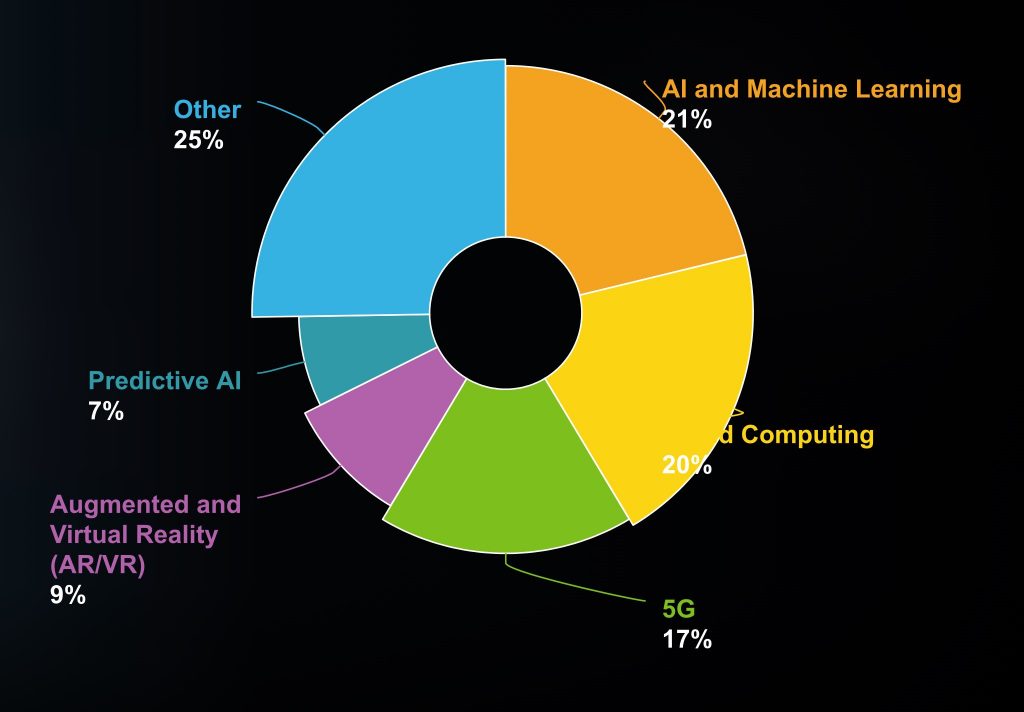Artificial Intelligence (AI) and Machine Learning (ML), Cloud Computing, and 5G will be the most important technologies in 2022, according to a new study conducted by IEEE called ‘The Impact of Technology in 2022 and Beyond.’ The report includes a survey of 350 CTOs, CIOs, and IT Directors, and other technology leaders at organizations with over 1,000 employees across multiple industry sectors, including banking and financial services, consumer goods, education, electronics, engineering, energy, government, healthcare, insurance, retail, technology, and telecommunications. Findings reveal the key technologies that will not only impact industries in 2022 but will dominate the next decade’s digital transformation strategies.
Technology, innovation, sustainability, and the future of industry and business

According to the IEEE study, technology leaders agree that Artificial Intelligence (AI) and Machine Learning (ML) will drive the majority of innovation across nearly every sector in the next 1 to 5 years. Other technologies driving innovation from 2022 onwards include Cloud Computing, 5G, Augmented Reality (AR), Virtual Reality (VR), and Mixed Reality (XR).
AI, Cloud, and 5G will lead innovation in 2022
Due to the global pandemic, 60 percent of technology leaders surveyed said in 2021 they accelerated adoption of Cloud Computing, 51 percent saw acceleration in adoption of AI and Machine Learning, and 46 percent saw an increase in 5G.
A total of 95 percent agree or strongly agree that AI will drive the majority of innovation across nearly every industry sector in the next one to five years.
According to technology leaders surveyed, the following areas will most benefit from 5G in the next year:
- Telemedicine, including remote surgery and health record transmissions (24 percent)
- Remote learning and education (20 percent)
- Personal and professional day-to-day communications (15 percent)
- Entertainment, sports, and live event streaming (14 percent)
- Manufacturing and assembly (13 percent)
- Transportation and traffic control (7 percent)
- Carbon footprint reduction and energy efficiency (5 percent)
- Farming and agriculture (2 percent)
Industry sectors most impacted by technology in 2022
According to the survey, 25 percent of technology leaders cited manufacturing as the sector that will be most impacted by technology in 2022, followed by financial services, healthcare, and energy. As compared to the beginning of 2021, 92 percent of technology leaders agree or strongly agree that implementing smart building technologies that benefit sustainability, decarbonization, and energy savings has become a top priority for their organization.
Impact of Covid-19 on workplace technologies and human resources
According to the study, hybrid work continues in 2022 and 97 percent of technology leaders agree or strongly agree that their team is working more closely than ever before with human resources leaders to implement workplace technologies and applications for office check-in, space usage data and analytics, Covid and health protocols, employee productivity, engagement, and mental health.
Cybersecurity for a hybrid workforce of remote and in-office workers is a top challenge for 2022, as agreed by 83 percent of respondents. Managing return-to-office health and safety protocols, software, applications, and data is seen as challenging by 73 percent. Other challenges include determining what technologies are needed for their company in the post-pandemic future and recruiting technologists to fill open tech positions in the year ahead.
The rise of robots becomes a reality over the next decade

According to IEEE, 81 percent of leaders agree that in the next five years, one quarter of what they do will be enhanced by robots, and 77 percent agree that in the same time frame robots will be deployed across their organization to enhance nearly every business function from sales and human resources to marketing and IT.
The deployment of robots will most benefit manufacturing and assembly (33 percent), hospital and patient care (26 percent), and Earth and space exploration (13 percent).
IoT: Increase of connected devices
As a result of the shift to hybrid or fully digital work during the pandemic, over 51 percent of technology leaders surveyed believe the number of devices connected to their businesses that need tracking and managing such as smartphones, tablets, sensors, robots, vehicles, and drones increased as much as 1.5 times, while 42 percent believe the number of devices has increased even more than that. IoT increase will continue in 2022 as many companies have adopted remote work moving forward. Technology leaders expect connected devices in their companies to grow exponentially in 2022.
Cyber and physical security, preparedness, and deployment of technologies
The cybersecurity top concerns expressed by technology leaders are those related to the mobile and hybrid workforce including employees using their own devices (39 percent) and cloud vulnerability (35 percent). Additional concerns include data center vulnerability, a coordinated attack on their network, and a ransomware attack.
Use of drones will increase in 2022
Almost 60 percent of all technology leaders surveyed currently use or are planning on using drones within the next five years for security, surveillance, or threat prevention as part of their business model. Current drone use for security or plans to do so in the next five years are strongest in this order: Brazil, China, India, the U.S., and the U.K..
Blockchain actively used in M2M/IoT
The top five most important uses for blockchain technology in 2022 will be as follows:
- Secure Machine-to-Machine (M2M) interaction in the Internet of Things (IoT) (61 percent)
- Shipment tracing and contactless digital transactions (51 percent)
- Keeping health and medical records secure in the cloud (47 percent)
- Securing connecting parties within a specified ecosystem (47 percent)
- Cryptocurrency exchange (43 percent)
Overall, due to the pandemic, companies have become more resilient much faster. A whopping 92 percent of global technology leaders participating in the IEEE survey believe that their company is now better prepared to respond to a potentially catastrophic interruption such as a data breach or natural disaster with many agreeing that this has been the result of the acceleration in preparedness. The full results of the IEEE survey can be found here.